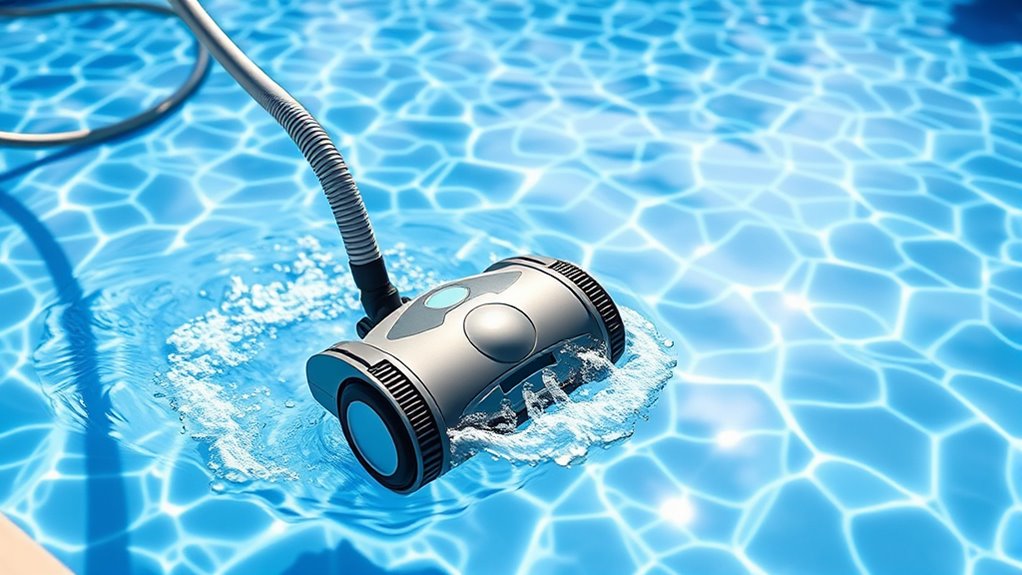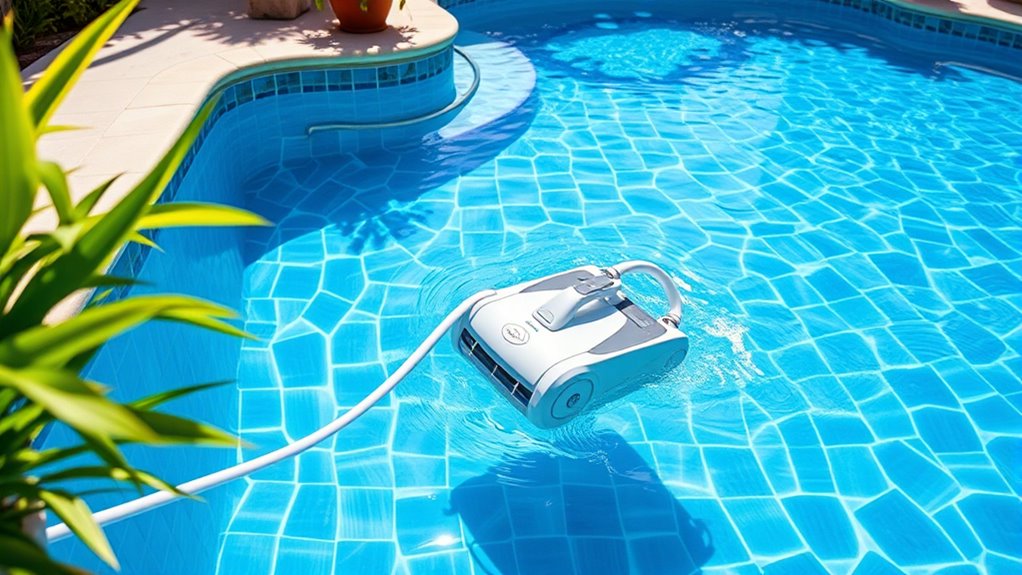To maximize your suction pool cleaner’s efficiency, start by thoroughly preparing the pool—remove large debris and ensure the water level is correct. Before operation, check that filters are clean and functioning well, and turn on the pump to create strong suction. Verify the navigation system works smoothly, and place the cleaner in a central or debris-prone spot. Regularly monitor performance and make adjustments as needed. Keep these tips in mind, and you’ll get better coverage and cleaner results every time.
Key Takeaways
- Ensure the navigation system is enabled and functioning properly before starting to achieve full pool coverage.
- Regularly inspect and clean filters to maintain optimal suction and prevent clogs.
- Remove large debris manually and check water levels for smooth operation and effective cleaning.
- Position the cleaner centrally or near debris-prone areas to enhance coverage efficiency.
- Monitor initial runs to identify and resolve any navigation or obstruction issues promptly.

A suction pool cleaner can make maintaining your pool much easier, but only if you use it correctly. One of the most important factors in guaranteeing efficient cleaning is understanding how your cleaner navigates your pool. Modern models often feature robotic navigation, which allows the cleaner to map out the pool’s surface and target dirty spots more effectively. Rather than randomly drifting around, a cleaner with good robotic navigation works systematically, covering every inch of the pool. To maximize this feature’s potential, make sure your cleaner’s navigation system is enabled and functioning properly. Keep an eye on its movements during initial uses to confirm it’s covering all areas without getting stuck or missing spots.
A suction pool cleaner’s robotic navigation ensures systematic, thorough cleaning—make sure it’s enabled and working properly for best results.
Equally crucial to your cleaner’s performance is filter maintenance. Your pool cleaner relies on its filter to trap debris and prevent clogs that could hinder suction power. Regularly inspecting and cleaning the filter ensures your cleaner operates at peak efficiency. A clogged or dirty filter reduces suction strength, meaning the cleaner won’t pick up dirt as effectively or may even stop working altogether. Check the filter basket or cartridge regularly—ideally after each cleaning session—and rinse it thoroughly with a hose. If you notice the filter is damaged or excessively dirty, replace it promptly. This simple step keeps your cleaner running smoothly and extends its lifespan. Additionally, understanding how filter maintenance impacts overall cleaning efficiency can help you avoid unnecessary repairs.
Another tip to enhance cleaning efficiency is to prepare your pool before using the cleaner. Clear away any large debris manually, as these can clog the filter or jam the suction system. Also, check that the water level is appropriate—too low, and the cleaner might lose suction; too high, and it could struggle to reach the pool’s bottom. Ensure your pool’s surface is relatively free of obstacles like toys, floats, or underwater décor that might obstruct the cleaner’s path or cause it to get stuck. Additionally, ensuring proper filter replacement according to your model’s guidelines helps maintain consistent suction power and prevents unnecessary downtime. Proper pool water levels and removing larger debris beforehand can significantly improve the cleaner’s efficiency during operation. Positioning your cleaner correctly at the start of each session helps it work more efficiently. Place it in the middle of the pool or near areas with the most debris. Turn on your pool’s pump first to guarantee good suction, then turn on the cleaner. During operation, monitor its progress, especially during the first few runs, to identify any issues with navigation or suction. If you notice it’s missing sections or not covering the entire pool, adjust its placement or check for obstructions. Remember, a well-maintained filter and proper setup are vital for optimal cleaning performance.
Frequently Asked Questions
How Often Should I Replace the Filter Cartridge?
You should replace your filter cartridge based on its condition and your filter maintenance routine. Typically, a cartridge’s lifespan is about 1 to 3 years, but it depends on usage and debris levels. Regularly check for signs of wear, such as tears or reduced suction. When you notice decreased performance or visible damage, it’s time to replace the cartridge to keep your pool clean and your cleaner functioning at its best.
Can I Use a Suction Pool Cleaner on an Uneven Pool Floor?
You can generally use a suction pool cleaner on an uneven pool floor, but check its pool surface compatibility first. Some cleaners handle uneven surfaces better, offering improved cleaner maneuverability. Make certain the cleaner is designed for your pool type and surface to prevent damage or ineffective cleaning. Regularly monitor its performance, and adjust the cleaner’s settings if needed, for maximum results across different pool terrains.
Does the Cleaner Work Better With Specific Pool Sizes?
Your suction pool cleaner generally works well across various pool sizes, but its efficiency depends on pool size compatibility. Smaller pools allow for quicker coverage and better suction, while larger pools may require a more powerful or larger cleaner to maintain ideal efficiency. Check your cleaner’s specifications to verify it’s suitable for your pool’s size, as this helps maximize cleaner efficiency and keeps your pool spotless with less effort.
How Do I Troubleshoot if the Cleaner Gets Stuck?
Think of your pool cleaner like a diligent traveler who sometimes hits roadblocks. If it gets stuck, check for common blockage points like the hose or brushes. Clear any debris that’s obstructing movement. If it still stalls, try a motor reset—turn it off, wait a moment, then restart. These simple steps can help your cleaner navigate smoothly again, ensuring your pool stays spotless without frustration.
Is It Safe to Leave the Cleaner in the Pool Overnight?
Leaving your suction pool cleaner in overnight is generally safe, but you should make certain the pool’s chemical balance is proper to prevent algae growth or corrosion. Also, avoid solar heating systems that could cause the cleaner to overheat or malfunction. Regularly check the cleaner and pool conditions, and remove the device if you notice any issues. Proper maintenance helps keep your cleaner working efficiently and your pool safe.
Conclusion
By following these simple tips, you’ll turn your suction pool cleaner into an unstoppable cleaning machine, transforming your pool from a murky mess to crystal-clear paradise in no time. Imagine never again battling stubborn dirt or wasting hours scrubbing—your pool will shine brighter than the sun itself! With just a little effort, you’ll experience the pure joy of a perfectly spotless pool every single day, making every swim feel like a luxurious retreat.









